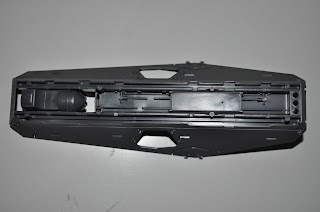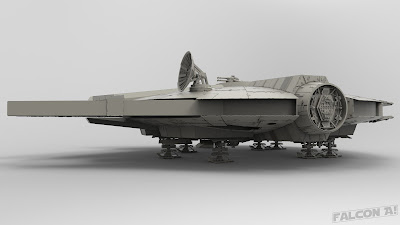I wasn't quite ready to talk about the saucer trenches so I'm going to start talking about the Falcon's jaws, which are the rectangular boxes on the top and bottom of the ship right in between the mandibles. When you think about it, the Falcon is much more insect-like than bird-like. Here's a render of the inside of the Falcon's jaws:
When modelers at ILM were kitbashing the Millennium Falcon and other ships for Star Wars, there were certain times where they made molds of assemblies of parts so they could reuse them in various places. The inner jaws contain the first example of one of these "plate" assemblies. As you can see in the following two renders, the upper and lower inner jaws are essentially the same.
This plate assembly is known as the 8Rad plate because the large rectangular part in the center is from the Tamiya 1:35 Schwerer Panzerspähwagen (8Rad) Sdkfz232 model kit.
This part in particular was used on many models in Star Wars, and if you've been paying attention, it's actually been used 3 times on my Falcon so far (though extensively trimmed down). It can also be found in the trenches of the 3 foot Star Destroyer...
And here it is on the Nebulon B Medical Frigate.
Here's a render of my 8Rad plate:
And here it is on the Nebulon B Medical Frigate.
Here's a render of my 8Rad plate:
And here is the kit part breakdown for the inner jaws:
The back wall of the inner jaws is the tank body of a Tamiya 1:35 Sheridan which looks like this:
As you can see the dimensions are a bit different and that's because the model makers cut out quite a bit from the middle of the tank body. Another cut down Sheridan body is used on the bottom of the Falcon, but we'll get to that later!
Here's a render of our progress so far:
Thanks for reading! Next time we'll be looking at the surface greebles of the jaw boxes.
P.S. I've found some updated part IDs so I have updated the docking ring and dish part maps.




















































